- Joined
- Oct 9, 2007
- Messages
- 47,895 (7.38/day)
- Location
- Dublin, Ireland
| System Name | RBMK-1000 |
|---|---|
| Processor | AMD Ryzen 7 5700G |
| Motherboard | Gigabyte B550 AORUS Elite V2 |
| Cooling | DeepCool Gammax L240 V2 |
| Memory | 2x 16GB DDR4-3200 |
| Video Card(s) | Galax RTX 4070 Ti EX |
| Storage | Samsung 990 1TB |
| Display(s) | BenQ 1440p 60 Hz 27-inch |
| Case | Corsair Carbide 100R |
| Audio Device(s) | ASUS SupremeFX S1220A |
| Power Supply | Cooler Master MWE Gold 650W |
| Mouse | ASUS ROG Strix Impact |
| Keyboard | Gamdias Hermes E2 |
| Software | Windows 11 Pro |
Asustor at Computex 2023 pointed us in the direction in which personal high-capacity storage, particularly NAS servers, are headed. The company unveiled its first pure-flash based NAS, and conventional HDD caddie-based NAS that have M.2 NVMe slots. The Flashstor 12 Pro (FS6712X) packs twelve M.2 NVMe slots, and is driven by a Celeron N5105 processor with 4 GB of DDR4-2933 memory on an SO-DIMM slot (which you can expand).
The M.2 slots support various NVMe RAID modes, including single, JBOD, RAID 0/1/5/6/10, etc. Besides these you get two 5 Gbps USB 3.2 ports. Networking interfaces include one 10 GbE. The company also unveiled a more compact version of this, with the Flashstor 6 (FS6706T), which comes with six M.2 NVMe slots, the same processor and NVMe RAID features, but two 2.5 GbE interfaces instead of the 10 GbE on the Flashstor 12 Pro.
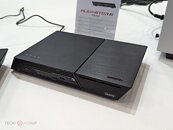
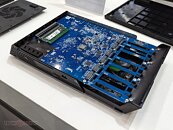
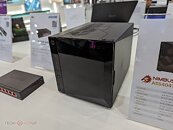
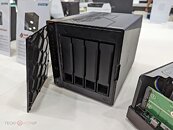
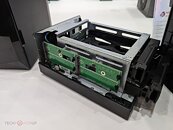
This trend of providing numerous M.2 NVMe slots with NVMe RAID capability continues across all the HDD-based NAS we were shown, including with the 4-bay Nimbustor 4 Gen 2 (AS5404T), which also provides four M.2 slots, and two 2.5 GbE interfaces; the 2-bay Nimbustor 2 Gen 2, which has two HDD caddies, but a healthy four M.2 NVMe slots with NVMe RAID capabilities; and two 2.5 GbE interfaces.
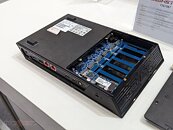
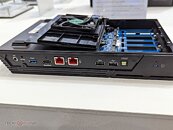
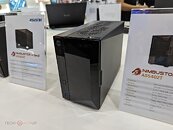
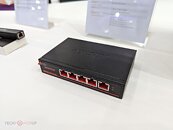
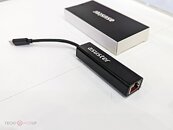
M.2 drives are, understandably, not as hot-swappable as HDDs, and so while the HDDs get convenient caddies, installing the M.2 drives involves taking off the top panel to expose a PCB with the four M.2-2280 slots. These use a tool-free (screwless) retention mechanism for the drives. On our way out, we caught a handful personal wired networking products, including a 2.5 GbE unmanaged switch, and AS-U2.5G2, a USB NIC that puts out a 2.5 GbE port, with a 5 Gbps USB 3.2 Gen 1 type-C on the other end (a type-A adapter is included).
View at TechPowerUp Main Site
The M.2 slots support various NVMe RAID modes, including single, JBOD, RAID 0/1/5/6/10, etc. Besides these you get two 5 Gbps USB 3.2 ports. Networking interfaces include one 10 GbE. The company also unveiled a more compact version of this, with the Flashstor 6 (FS6706T), which comes with six M.2 NVMe slots, the same processor and NVMe RAID features, but two 2.5 GbE interfaces instead of the 10 GbE on the Flashstor 12 Pro.





This trend of providing numerous M.2 NVMe slots with NVMe RAID capability continues across all the HDD-based NAS we were shown, including with the 4-bay Nimbustor 4 Gen 2 (AS5404T), which also provides four M.2 slots, and two 2.5 GbE interfaces; the 2-bay Nimbustor 2 Gen 2, which has two HDD caddies, but a healthy four M.2 NVMe slots with NVMe RAID capabilities; and two 2.5 GbE interfaces.





M.2 drives are, understandably, not as hot-swappable as HDDs, and so while the HDDs get convenient caddies, installing the M.2 drives involves taking off the top panel to expose a PCB with the four M.2-2280 slots. These use a tool-free (screwless) retention mechanism for the drives. On our way out, we caught a handful personal wired networking products, including a 2.5 GbE unmanaged switch, and AS-U2.5G2, a USB NIC that puts out a 2.5 GbE port, with a 5 Gbps USB 3.2 Gen 1 type-C on the other end (a type-A adapter is included).
View at TechPowerUp Main Site

